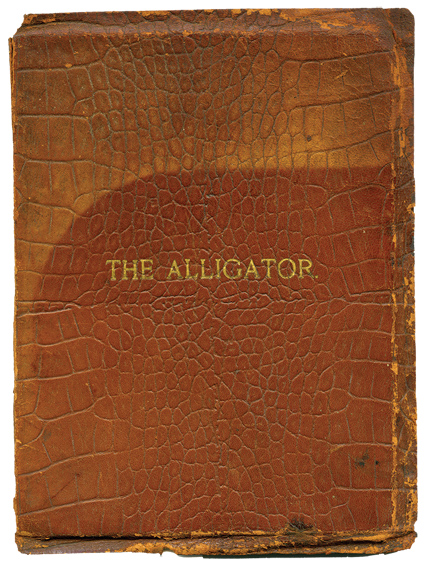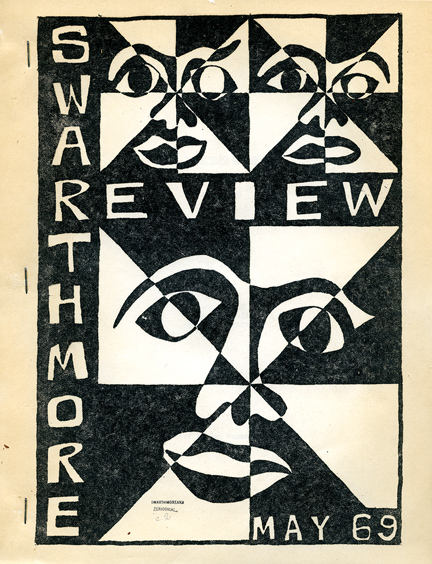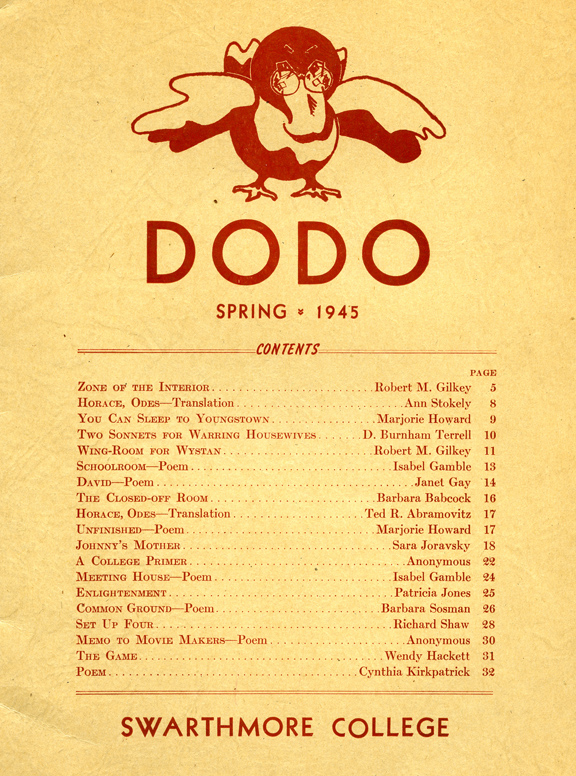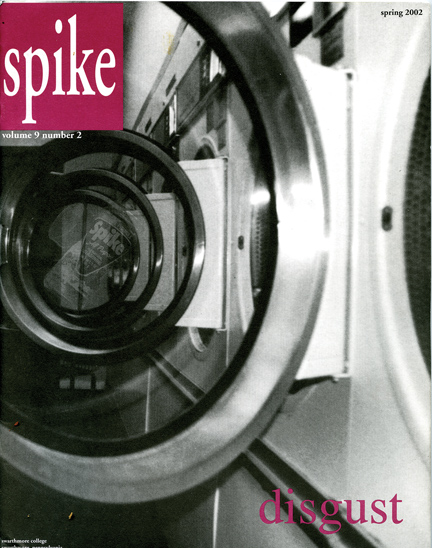Earnest and Edgy
Literary magazines, whether ephemeral or durable, have enlivened student life at Swarthmore through the eras.
This paper originated in a humble desire to introduce into college life a little spice, to vary the monotony of those essays of a multifarious character, some economical, some critical, some philosophical, which characterize a college journal.
Thus opens issue one of The Alligator, Swarthmore’s first student publication, founded in 1887. As a statement of purpose, it can’t be beat. I almost wish I had uttered those 37 words when I was standing in front of the Swarthmore Student Budget Committee in 2008, explaining why I’d just put out a magazine, Night Café, and why it should give me money to keep it running.
My purse-string-holding audience was skeptical. What were we actually doing that The Phoenix couldn’t? Besides, there was no money left in the budget, and the literary magazines that existed were folding due to lack of submissions. The field was saturated. We’re going to be like so different from the pamphlet-sized books of poetry and short autobiographical fiction put out by various student groups, I explained. We’re going to be a real general-interest magazine. Like The Atlantic or New York Review of Books, a hub of nonacademic intellectual life. But hopefully cooler. My claims grew yet grander. The deliberations continued as I waited outside in the hall, for literally hours.
After the committee denied us funding, we organized a letter-writing campaign; 35 people wrote in support. The last day of the semester, we were awarded $6,000.
Everyone enters college believing deep down that the immediately visible status quo is how things always have been. I had the same thought before I plumbed the musty archive in McCabe’s Rare Book Room shortly after I graduated. It houses every issue of every literary magazine that its heroic campus librarians have managed to track down. Had I surveyed such specimens as the Roc, the Dodo, the Vulture, the Grouse, the Tupenny Puffin (notice a theme?) the “bee in my bonnet”—as Jonathan Franzen ’81 describes the mad magazine-starting impulse among Swarthmore students—would I have felt a new satisfaction at entering a well-formed tradition?
I found this trove of curiosities that went a long way towards illuminating the development of the student literary experience at Swarthmore. Following are some highlights.
1887: The Alligator
The Alligator is the urtext, the common ancestor from which all of Swarthmore’s magazine culture descends. Almost illegibly scrawled in longhand, bound in scaly brown leather, The Alligator has a mysterious aura, though it’s permeated with familiar elements. It was edited by “The Cabal,” whose monikers, Phite, Petros, Baron, and Bah, seem straight out of Hogwarts. Printing services are attributed to one Devil Mac, and branch offices are claimed in London, New Jersey, and Paris.
“Nota Bene,” The Alligator announces beneath its masthead. “Subscribe early to avoid the rush.” This is followed by an illustration of a skinny youth with an even skinnier neck dressed in clogs and pantaloons and carrying what looks like a wood splitter. “Our Office Boy Soliciting Subscriptions” reads the caption.
The comics and sketches look like a Ralph Steadman version of the 19th-century caricaturist Honoré Daumier. Snake-infested skulls and pipe-smoking lizards hobnob with cravat-wearing buffoons and long-nosed fishermen. A Sisyphus in tails and a top hat lifts a giant boulder marked “Thesis.” (That allegory would seem all too relevant to Swarthmore’s contemporary seniors.)
The sensibility seems almost Dadaist at times. An announcement in the middle of the issue reads:
Wanted: A Bath by X.Y.Z.
Lost: A Freshman with a Wart on his Nose, two miles North of Media.
Found: On the sofa, in the parlor:
“Fur Spoons”
1937: The Bullet
The next significant literary magazine didn’t come along until the Great Depression. The Bullet was exclusively devoted to laying out a mock political platform for something that it calls “Straight-Shooting Americanism: a satirical laissez-faire” ideology. “We are at present experiencing the worst industrial decline in the history of the nation, which is rapidly undermining the morale of big business, and of the leisure classes,” announce The Bullet’s anonymous editors, on no-nonsense brown newsletter stock. “To stave off a threatened flight of gold from the dollar, and of aristocracy from the country, The Bullet presents its Recovery Program.”
The Bullet shares with The Alligator elements of surrealism and Gonzo lunacy; its suggestion was to erect “large public reservoirs in the vicinity of Wall Street to be filled with eyewash, in which idle bankers may float bonds.” However, it is a much more focused and pointed document, presenting a scathing caricature of the American right’s ability to use economic crises to advance plutocratic values. This is a message that resonates eerily with the present.
W.H. Auden
1939–1954: The Dodo
The Dodo, which launched a mere two years after The Bullet folded, could not have been a more different animal, in style and content. Artfully laid out in crisp print on glossy white paper, it was the first truly polished, well-established student-run magazine in the Swarthmore annals. W.H Auden H ’64, was a frequent Dodo contributor when he was on the faculty in the early ’40s; another prominent figure was Diane DiPrima ’54, the Beat poet, alchemist, and tarot reader (currently poet laureate of San Francisco) who dropped out of Swarthmore to live in Manhattan.
As its name self-deprecatingly prophesied, the Dodo did go extinct. But not before standing for 15 years as the campus literary standard and inaugurating what was surely the golden age of Swarthmore publications, which lasted up until the early 1960s.
Similar to the early New Yorker, the Dodo balanced its heavyweight literary roster with a distinct levity of spirit. The tone is less absurdist or satirical than simply insouciant, perhaps even a bit twee. Ogden Nash is an evident formal influence (“You Wake Me every Single Morn/by loudly tooting your own horn/It’s really not sophisticated/to be so Egotisticated,” wrote Erwin Ephron ’54, who would go on to be known in the advertising world as “The Father of Media Planning.”
Some issues of the Dodo begin with a column called Moultings, analogous to The New Yorker’s Talk of the Town, in which the editors hold forth on a subject of concern. “What good are English majors to a nation at war?” they ask in 1940. “Well, we might suggest that they be dropped instead of bombs, just to scare the Germans. Seriously though, we think that the enrollment in the Humanities should be just as high now as it ever was. The job that we will have after this war of mopping up broken ideas and broken lives is going to make our present efforts look small.”
“Even now,” they conclude, “in the middle of the conflict, [the English major] can be of tremendous use in making propaganda … and in any number of little ways, like cleaning up after the parades go by.”
The 1950s: The Lit and Nothing
What finally killed off the Dodo in 1954? I was unable to reconstruct its demise. It had, by all appearances, a healthy advertising base among Swarthmore businesses, a consistent editorial voice, and a solid coterie of regular contributors. I can only speculate that it fell victim to a general principle of Swarthmore publications: Old literary magazines aren’t cool. You know what’s cool? New literary magazines.
A case in point: just the Dodo’s display font makes me want to put on a starched white blazer and head directly to the nearest post-Prohibition jazz and martini bar. The new bad boy on the scene, The Lit, was, despite appearing outwardly as a carbon copy of the Dodo, where the action was. The rhyming quatrains were still there, just now existentialist flavored. As contributor Charles Sullivan ’55 quipped in “The Rise of Western Man,” “Twinkle, twinkle, little chi-chi/How I wish that I were Nietzsche: Far above the earth so bright/In the syphilitic night.”
The Lit’s editors, Victor Navasky ’54 recalled, were a tight-knit group that included Hugh Nissenson ’55, who would go on to become an award-winning novelist, and Valerie Worth ’55, a future children’s book author. They “saw themselves as having affinity with Fitzgerald and Gertrude Stein: The Lost Generation,” says Navasky, editor emeritus of The Nation. “There was some snobbery involved,” he admits, in the group’s idolization of European culture, partially explained by the fact that Albert Camus’ The Stranger came out their senior year.
The second issue of The Lit was a rollicking francophilic tour de force. The bulk of it consisted of profiles by editor-in-chief Edward Esmerian ’54, who somehow managed to score (or pretend to score) interviews with dozens of major Parisian artists and intellectuals, including Jean Cocteau, Camus, and Fernand Léger. The Lit’s moody pretensions were satirized by The Flit, a contemporary publication whose raison d’etre was parodying the former:
In the café at the corner of the Rue des Deux Haricots … flickering candles sink into the sucking necks of green encrusted bottles. Tired flies waltz erotically over the heads of gloomy intellectuals. The poete [sic] sits sulkily, his feet poised on a nearby garbage can, perusing l’humanity with Weltanshauung bereft of inspiration.
Then the eccentric, short-lived Nothing took the whimsical art of sending up boho, Euro-aping intellectual patter to the next level. “We feel there is an ultimately useful place in Art and in Society for a sophisticated, self-conscious nihilism,” opened its first issue. It featured “A Play WITH VERY FEW ACTS AND NO CHARACTERS AT ALL (Curtain),” along with a Beckettian satire called “Waiting for Pogot”:
Adler: What are we doing here anyways
Sailor: We’re Waitin’ for Pogot.
Adler: Ah. I think we should hang Ourselves.
Sailor: Hang Ourselves? That is whuffo?
Adler: It might give us an APPETITE
Sailor: I HAVE an appetite
Adler: Think of it! You might have TWO appetites—a hitherto of RUMINANTS an’ other privileged classes.
Nothing, calling itself “the magazine of togetherness,” produced several tiny, origami-esque issues, with baubles such as a dried leaf lovingly stapled to the cover of each copy, which was covered with quips, sketches, one-liners, and other curated oddities. Nothing’s second volume, titled the Great Welschmertz issue, folds into a kite shape. Stamped on the front is the slogan GOD IS FOOD above a blue fleur-de-lis, and a man smoking six pipes at once, a bird head wafting from the left-most one. The style is highly reminiscent of The Alligator.
The ’60s: Earnestness and Edge
Call it charm, call it sophistication, call it preciousness, or aestheticism. Whatever animated the prolific Swarthmore magazines of the ’40s and ’50s with preening concern for typography, design, and high-falutin editorial flair, it had departed by the early ’60s. No more Lit, no more Nothing, no more Grouse, (a publication that was dedicated, quite literally, to elegant grousing.)
When the Baby Boomers got to Swarthmore, they were scrupulously and unprecedentedly square and dutiful, any bourgeois niceties seemingly purged by a commissar memo. Representative publications like the OCAC Newsletter and the inaptly named Snark were admirably principled in their devotion to bone-dry enumeration of political detail.
The work of Diane di Prima ’54, now poet laureate of San Francisco, appeared in the Dodo.
After the literary desert of the early and mid-’60s, the Swarthmore Review appeared like a bolt from the blue in 1969. Sharing the era publications’ unconcern with design values, it was filled with raw, bizarre, provocative, sometimes juvenile literary experiments. These recalled John Barth’s Lost in the Funhouse and occasionally Burroughs’ Naked Lunch. Co-founder Don Mitchell ’69, an accomplished fiction writer who teaches at Middlebury College, confirmed the publication’s title.
Calling it Swarthmore Review had been, in retrospect, a “wrongheaded … attempt to drape ourselves in the mantle of the college,” when it was in fact a thoroughly rogue publication, Mitchell explains. Well, perhaps not thoroughly rogue: Many of the stories were produced by Mitchell and co-editors Barry Yourgrau ’70 and Nick Kazan ’67 for academic credit, in the first creative-writing seminar at Swarthmore College.
Nonetheless, the Swarthmore Review was the opening volley in what would be three successful careers. Kazan, son of the director Elia Kazan, has been a playwright and a Hollywood screenwriter, while Yourgrau is a multimedia cabaret artist, doyen of very short fiction, and essayist.
Right after college, Mitchell got a book deal and screenplay option for a short-story collection that his Swarthmore writing teacher had encouraged him to pen about his adventures hitchhiking across the country. In “Toni Warlock,” for instance, published in the Swarthmore Review, Mitchell’s narrator is propositioned by a homosexual occultist who picks him up just south of Big Sur, Calif. This and similar stories were published as Thumb Tripping: Everything You Need to Know About the Marijuana Society, with a lurid, psychedelic cover, in 1971.
“It’s kind of shocking,” Mitchell reflects, “that all three of us made it as creative artists of one kind or another.”
The ’70s and ’80s: Polemics, Postmodernism, and Jonathan Franzen
The 1970s continued, to some extent, the darkly libertine spirit that first appeared in the Swarthmore Review. The establishment poetry magazine The Nulset Review was moderately more edgy but still had nothing on Mitchell, Kazan, and Yourgrau’s production. A new spirit, however, had also emerged on the scene: that of identity politics.
The identity-based student literature of the 2000s has a distinctive nature: individualistic, expressively poetic, based on personal crisis or defiance. A characteristic poem from Mjumbe, Swarthmore’s first African-American literary publication, reads: “I Don’t Like Being Choked By Your Narrow Margins That’s NOT ME! / I want to pick and choose / And taste and wriggle / so don’t bind you by binding me.”
Yet the publication’s early issues were unapologetically universalist and polemical, collectively written manifestos in favor of black humanism, defined as “The manner and action by which The Material Things are used to carry out The Idea without exploiting, messing over, messing up, or hustling other people and nature.” But a few semesters later, it had become something closer to its current incarnation.
During the ’80s, at least three substantial (and fairly interchangeable) new long-form cultural magazines appeared (The Bystander, Collection, and Magazine), marking the birth of that genre in the Swarthmore repertoire. They were distinguished by neither having a firm editorial viewpoint (as in the anti-McCarthyite OCAC or right-baiting Bullet), nor by setting a literary tone, as did The Lit, or even The Alligator in its own deranged way. Such urgent concerns as divestment in South Africa, abortion, the contemporary role of ’60s and ’70s radicalism, and the ontological status of Reagan (was he really human or some cruel media-generated simulacrum?) were considered cogently and evenhandedly.
The specter of postmodernism impinged on the debate. A common theme sounded was the (now fairly clichéd) sense of instability between fiction vs. reality, whether in government and media rhetoric or creative authorship. William Saletan ’87, now a Slate commentator, wrote an essay on the former; Shoshana Kerewsky ’83, a fiction writer, tackled the latter.
Jonathan Franzen was in his formative years at Swarthmore, writing dialogue in his playwriting seminar, and eventually helming the The Nulset Review, which he renamed the still-current Small Craft Warnings. He offers a bit of insight into the naming process: He and his co-editors thought that Nulset (a pun on the math term Null Set) smacked too much of ’70s style “ ‘antic nihilism’ … and I didn’t like ’70s antic nihilism,” he says. Small Craft Warnings was the suggestion of Franzen’s hall mate and best writer friend Tom Hjelm ’81, who Franzen said had a critical influence on the early development of his art.
“We [learned by] ridiculing each other’s writing. And the great thing about a small school was, very quickly we ended up as editors. You really learn a lot in a hurry about your own prose [by] editing someone else’s.”
The ’90s and beyond: The Great Fragmentation, spike, and what’s next?
By the early ’90s, the angst-ridden, contested postmodernist instability of the 1980s cultural ’zines (all interchangeable vessels of confusion and conflict) had resolved, on the one hand, into total fragmentation; on the other, the more confident, self-aware postmodernism of Spike.
“Identification” ruled much of the literary scene. There were magazines for the Jewish group, Asian Americans (Celebrasian), Spanish speakers, campus conservatives (which was funded by outside organizations) and women’s issues; one magazine, Ourstory, was dedicated to identity questions. In the globalized, multicultural 1990s, issues of stereotyping, cultural representation, empathy, appropriation, and exoticism, were primary concerns. The genres of preference were short personal essays and poetry.
Design values, particularly in Celebrasion (which paid close attention to layout) often were impressive. For its sheer profusion of magazine content and enthusiasm, the ’90s may have rivaled the ’50s as the golden age of Swarthmore publications.
This could be due to the status the medium enjoyed in the culture at large: “In the mid-’90s, magazines were awesome,” said Jason Zengerle ’96, who co-founded Swarthmore’s long-running humor magazine Spike. He is now a journalist and senior editor at The New Republic. Might magazine, started by novelist Dave Eggers in the early ’90s, was a direct inspiration for Spike.
For the first decade or so of its run, Spike perfected a distinctly collegiate blend of erudition, irreverence, oblique political commentary and lowbrow sensibility. (A feature article that perfectly captured all of these qualities was “Choose Your Own Adventure,” in which the reader gets to play a developing country in a budgetary crisis.)
Spike’s continued success was owed to a sequence of talented editors, including Christine Smallwood ’03, who went on to be an editor at The Nation, and Mark Lotto ’00, a senior editor at GQ.
“Some of my successors [such as Mark] were really smart; they were doing things that were much wittier than us,” Zengerle continues.
Zengerle was clearly pleased that some legacy of his publication has survived, even though Spike couldn’t maintain its energy and is now published once per semester, according to the College website. In the last decade, Night Café was renamed Nacht Magazine and found a niche somewhere between social commentary and the millennial avant-garde. Other literary magazines listed on the site are Mjumbe; ñ (Enie), published in Spanish; remappings (representing the Asian community); and Small Craft Warnings.
The wider media world seems to have collapsed into a welter of search-engine-optimized blips interspersed with celebrity gossip and gratuitous photographs of Sarah Palin. Nonetheless, innovative startups like Lapham’s Quarterly, Cabinet, Canteen, Triple Canopy, and Wag’s Revue (an online, non-ADD-inducing ’zine started by Brown students) have sparked a thriving indie publishing scene to satisfy the lust of the most ravenous, discerning magazine aficionado.
If there is a silver lining to the decline of magazine publishing, one has to look to history to discover it. In 1900, when photography challenged the dominance of painting, it provoked self-interrogation and a realignment of the medium; it had to figure out what it fundamentally was. If magazine culture is going to do something similar, a good place to start might be those dusty archives where unsung Swarthmore librarians have been saving us a piece of our tradition.
Eli Epstein-Deutsch ’10, who majored in modernist studies, was the founder of Night Café, now Nacht Magazine. He is a freelance editor in New York City and is helping curate a show of contemporary Chinese art for the soon-to-open Kunsthalle Beacon in New York near Dia:Beacon.
 Email This Page
Email This Page



